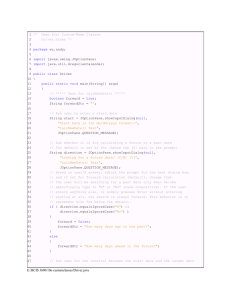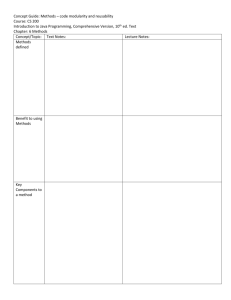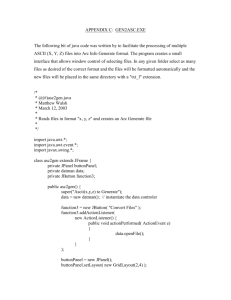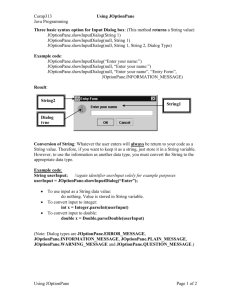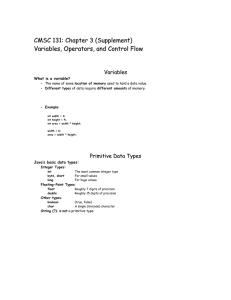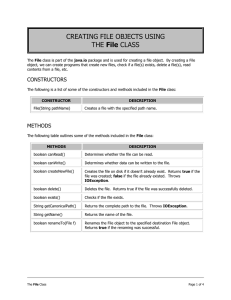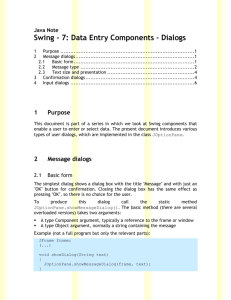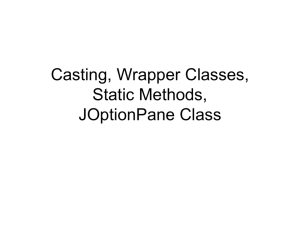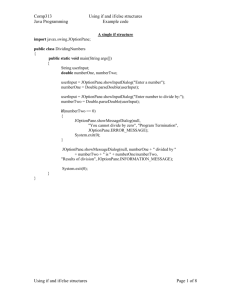Notes, Wu chapter 2 part 2 - Kirkwood Community College
advertisement
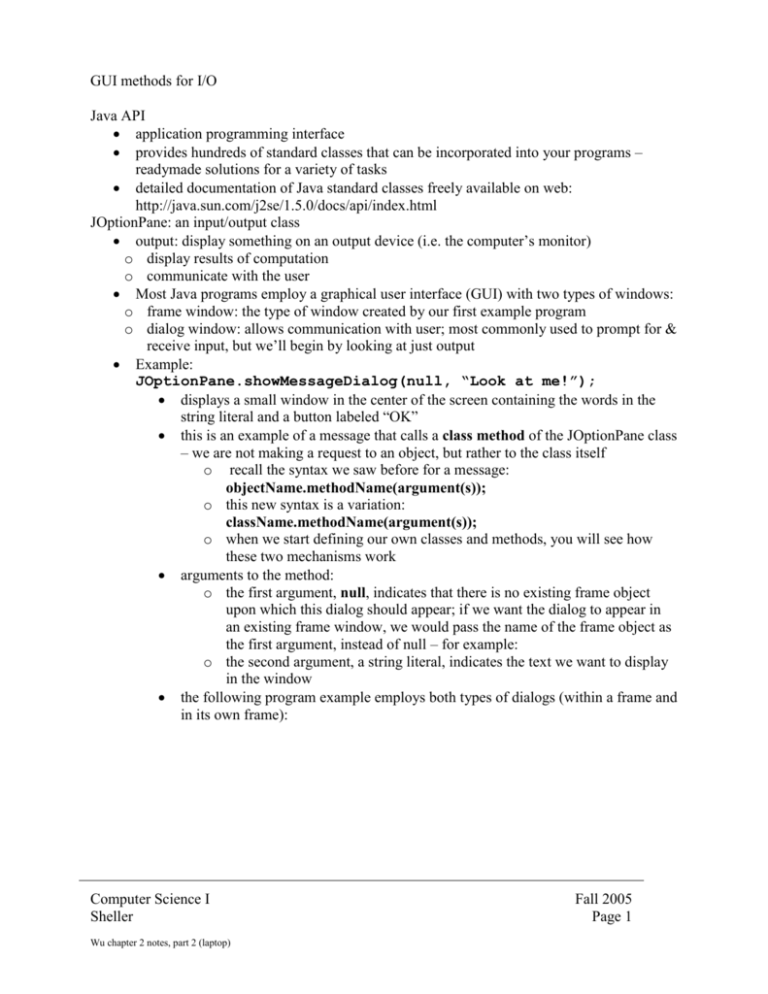
GUI methods for I/O
Java API
application programming interface
provides hundreds of standard classes that can be incorporated into your programs –
readymade solutions for a variety of tasks
detailed documentation of Java standard classes freely available on web:
http://java.sun.com/j2se/1.5.0/docs/api/index.html
JOptionPane: an input/output class
output: display something on an output device (i.e. the computer’s monitor)
o display results of computation
o communicate with the user
Most Java programs employ a graphical user interface (GUI) with two types of windows:
o frame window: the type of window created by our first example program
o dialog window: allows communication with user; most commonly used to prompt for &
receive input, but we’ll begin by looking at just output
Example:
JOptionPane.showMessageDialog(null, “Look at me!”);
displays a small window in the center of the screen containing the words in the
string literal and a button labeled “OK”
this is an example of a message that calls a class method of the JOptionPane class
– we are not making a request to an object, but rather to the class itself
o recall the syntax we saw before for a message:
objectName.methodName(argument(s));
o this new syntax is a variation:
className.methodName(argument(s));
o when we start defining our own classes and methods, you will see how
these two mechanisms work
arguments to the method:
o the first argument, null, indicates that there is no existing frame object
upon which this dialog should appear; if we want the dialog to appear in
an existing frame window, we would pass the name of the frame object as
the first argument, instead of null – for example:
o the second argument, a string literal, indicates the text we want to display
in the window
the following program example employs both types of dialogs (within a frame and
in its own frame):
Computer Science I
Sheller
Wu chapter 2 notes, part 2 (laptop)
Fall 2005
Page 1
// Sample program displaying messages using JOptionPane.showMessageDialog
import javax.swing.*;
class Example2 {
public static void main (String [] args) {
jFrame myWindow;
myWindow = new JFrame();
myWindow.setSize (300, 200);
myWindow.setVisible(true);
JOptionPane.showMessageDialog(myWindow, “It’s my window”);
JOptionPane.showMessageDialog(null, “and I’ll cry \n if I want to”);
}
}
Displaying multiple lines of text: the special character ‘\n’ represents the control
character you get when you press the Enter key on the keyboard (n = new line)
Later on, we’ll introduce another JOptionPane class method that allows us to take
keyboard input from the user
Reading Input
In order to receive input data from a user, we need two things:
a mechanism by which to read the data
a place to store the data
We can use another method, showInputDialog, of the JOptionPane class for the first part; we can
use a String object for the second part.
The showInputDialog method:
The syntax for showInputDialog is almost identical to the previous JOptionPane method we
looked at, showMessageDialog. You may recall from a previous example program the following
lines of code:
JOptionPane.showMessageDialog(myWindow, “It’s my window”);
JOptionPane.showMessageDialog(null, “and I’ll cry \n if I want to”);
In general, the syntax for both showMessageDialog and showInputDialog is:
JOptionPane.methodName (WindowObject, MessageObject);
We know from the examples that the first argument, the WindowObject, can either be a JFrame
object we have declared and initialized or null; we also know that the second argument can be a
String literal value.
The difference between the two methods is that showMessageDialog merely displays a window
containing the specified message, but showInputDialog method displays the message as a
Computer Science I
Sheller
Wu chapter 2 notes, part 2 (laptop)
Fall 2005
Page 2
prompt, followed by a space for the user to enter input. For example, the following code
fragment produces a dialog window like the one shown below:
String daddy;
daddy = JOptionPane.showInputDialog (null, “Who’s your daddy?”);
Reading Numeric Input
We have already seen that we can read Strings via a showInputDialog window
It turns out we can use the same mechanism to read other kinds of data, but it takes a little
more work
In order to transform the String returned by showInputDialog into a number, we must
perform a type conversion
Type conversion of a string to a numeric type is accomplished using various parse
methods, which are members of the numeric wrapper classes
Wrapper classes exist as a bridge between simple types (like int or double) and object
types (like String)
The following code fragment illustrates the mechanism:
String input;
int userAge;
input = JOptionPane.showInputDialog
(null, “Enter your age in years”);
userAge = Integer.parseInt(input);
In the example above, the wrapper class is Integer, and the parse method is parseInt
Some other useful wrapper classes include Long, Float and Double, and their
corresponding parse methods, parseLong, parseFloat and parseDouble
The general syntax for conversion of a String to a number is:
WrapperClassName.parseMethod(String)
where WrapperClassName is Integer, Double, etc. and parseMethod is parseInt or
parseDouble, etc. and String is a String object containing the text to be converted
Computer Science I
Sheller
Wu chapter 2 notes, part 2 (laptop)
Fall 2005
Page 3
